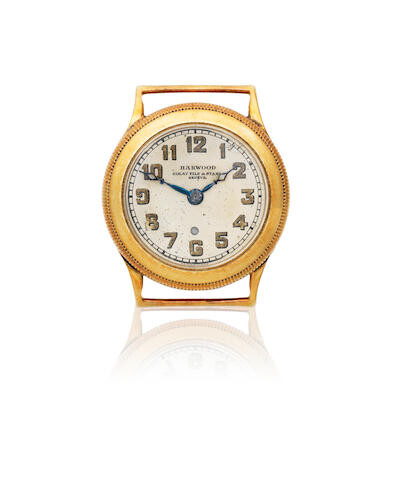Harwood for Golay Fils & Stahl, Genève. A mid-size 14K gold automatic watch
Circa 1930
Date: Circa 1930
Movement: 15-jewel bumper automatic, adjusted to 2 positions, Patent No.106583
Dial: Silvered, luminous filled Arabic numerals, black outer minute track with 5 minute markers, aperture at 6 to indicate when time setting is engaged, blued steel cathedral hands with luminous tips
Case: Polished round, snap on back, reeded bi-directional bezel for hand setting, fixed wire lugs, No.294364
Signed: Dial & movement
Size: 29mm
John Harwood is credited for inventing the first automatically wound watch mechanism, which was patented in 1924.
In seeking greater accuracy Harwood identified ingress of dust and moisture as key inhibiting factors and sought to eliminate them by incorporating the winding mechanism inside the case of the watch. Harwood is said to have been inspired by a see saw when inventing his bumper wound movement, where the pivoting weight swings through 180 degrees limited by swing bumpers that propel the weight back and forth to encourage the motion which winds the watch.
The watch has no crown, providing a better seal to the case, and the hands are set by rotating the bezel. A dot at the six o'clock position indicates when the hand setting is engaged (white) and when the watch is running (red).
View it on
Estimate
Time, Location
Auction House
Circa 1930
Date: Circa 1930
Movement: 15-jewel bumper automatic, adjusted to 2 positions, Patent No.106583
Dial: Silvered, luminous filled Arabic numerals, black outer minute track with 5 minute markers, aperture at 6 to indicate when time setting is engaged, blued steel cathedral hands with luminous tips
Case: Polished round, snap on back, reeded bi-directional bezel for hand setting, fixed wire lugs, No.294364
Signed: Dial & movement
Size: 29mm
John Harwood is credited for inventing the first automatically wound watch mechanism, which was patented in 1924.
In seeking greater accuracy Harwood identified ingress of dust and moisture as key inhibiting factors and sought to eliminate them by incorporating the winding mechanism inside the case of the watch. Harwood is said to have been inspired by a see saw when inventing his bumper wound movement, where the pivoting weight swings through 180 degrees limited by swing bumpers that propel the weight back and forth to encourage the motion which winds the watch.
The watch has no crown, providing a better seal to the case, and the hands are set by rotating the bezel. A dot at the six o'clock position indicates when the hand setting is engaged (white) and when the watch is running (red).



